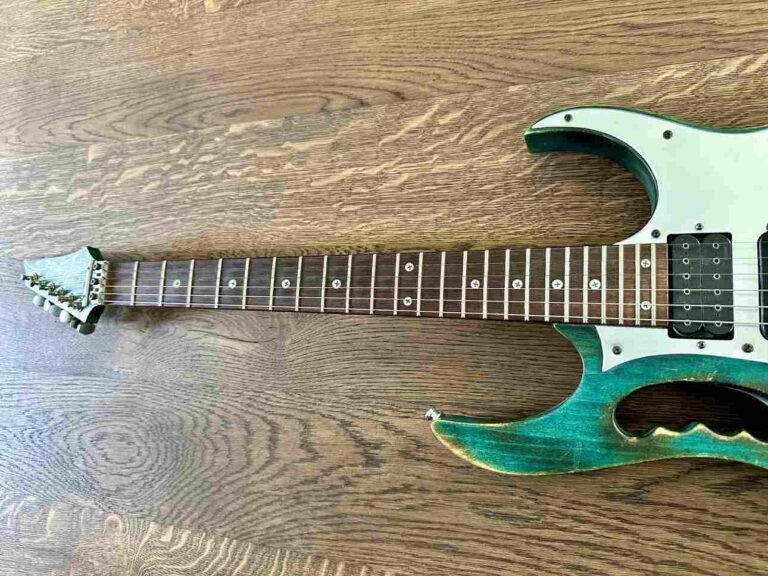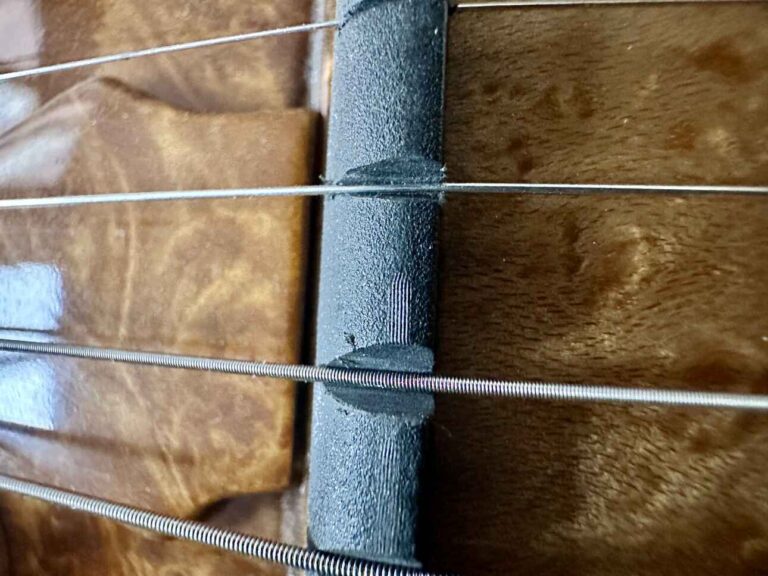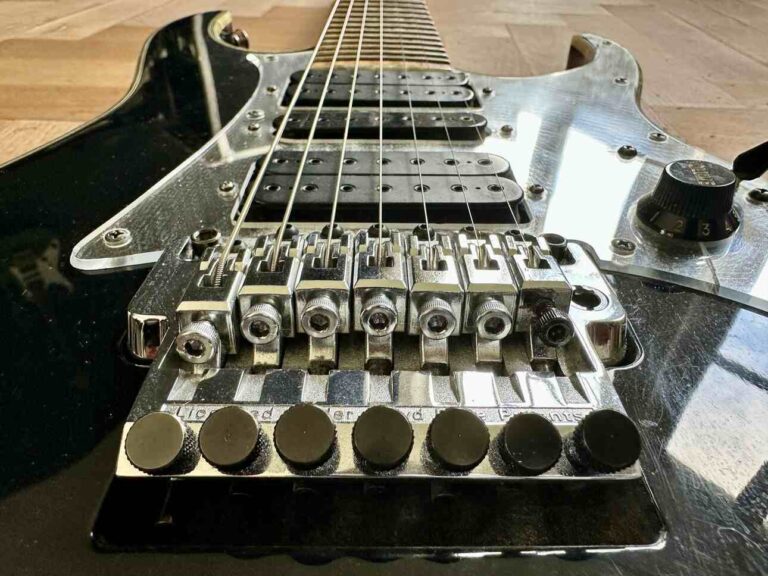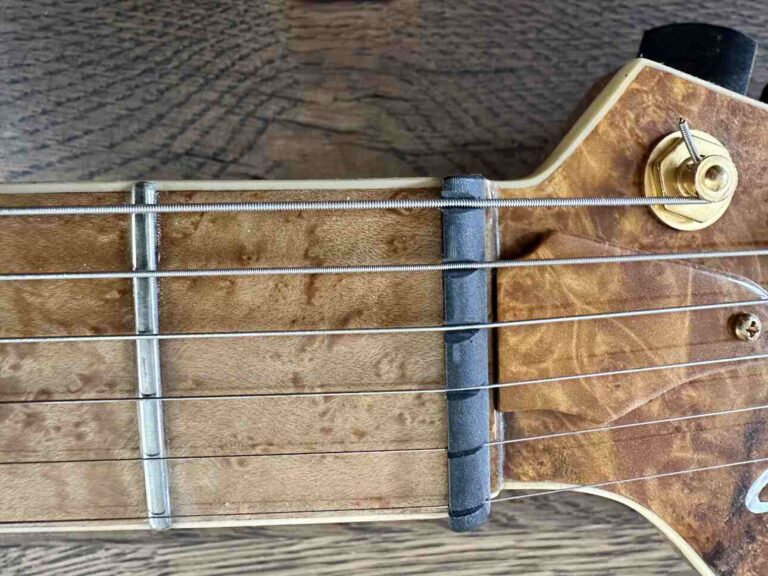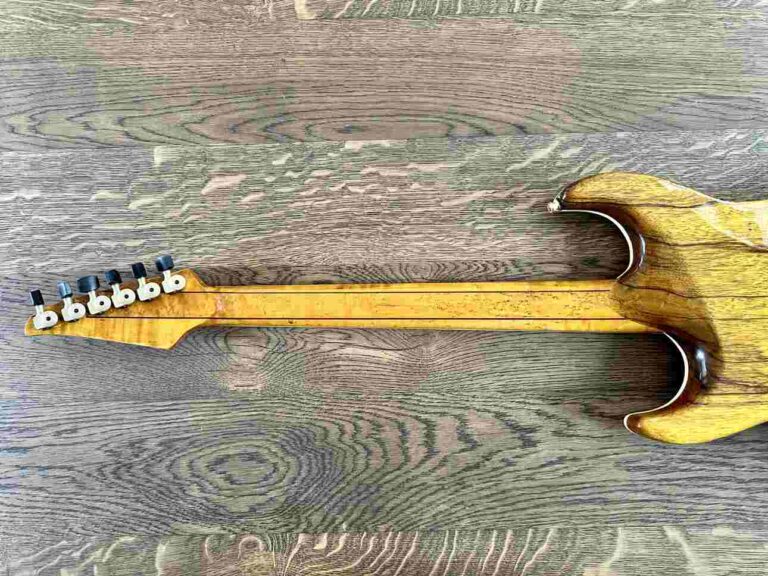Why do guitar necks taper? Crucial Feature of The Fingerboard
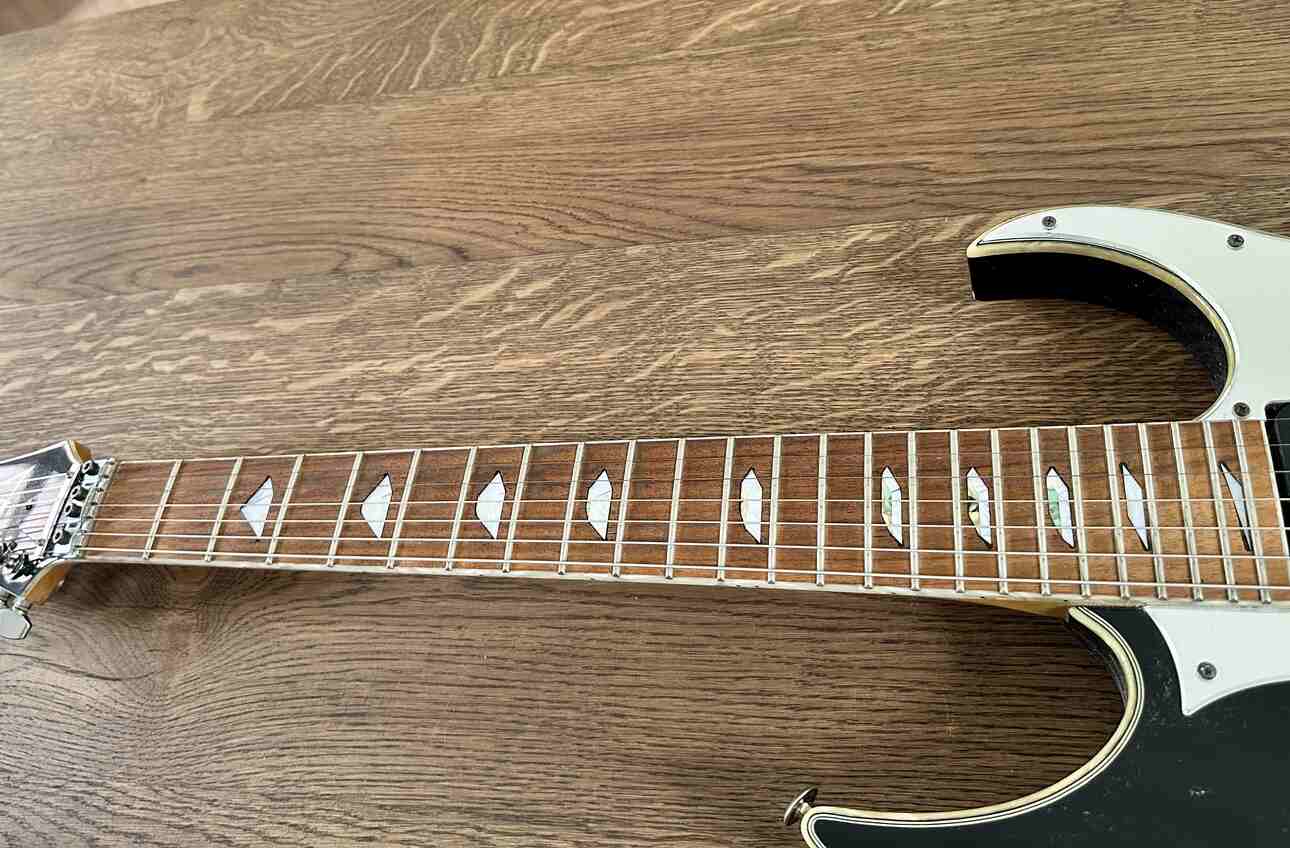
Guitar necks taper to make playing easier. When you move your hand up and down the neck, the change in width helps your fingers reach the different strings and frets more comfortably. But the type of taper best for you depends on your preferences.
This feature is handy for playing chords and scales. It makes for a better guitar experience. Basically, you’ll have more fun playing it.
The neck starts thinner near the nut, where the tuning pegs are, and gets wider as it goes towards the guitar’s body. This design fits the natural shape of your hand. It allows for easier transitions between notes and chords.
It’s a subtle but important detail that impacts your interaction with your guitar.
Different guitars have different neck shapes and tapers. Some may be more suited for fast playing styles. Others might feel more comfortable strumming chords.
Understanding these differences can help you choose a guitar that fits your playing style best. So if you wanna know more, read on!
Key Takeaways
- Guitar necks taper for easier hand movement;
- The taper helps in playing chords and scales smoothly;
- Different neck shapes suit different playing styles.
Basics of Guitar Anatomy
Understanding the Neck
The neck of a guitar holds the fretboard, frets, and strings. It’s usually made from wood like maple or mahogany.
The neck shape can affect your playing comfort and style.
One important part is the nut, which is found where the neck meets the headstock. It holds the strings in place and affects tuning and playability.
Guitars have different neck profiles, from thin to thick. This influences how they feel in your hands.
A well-made neck helps maintain tuning stability and supports the strings effectively.
Role of the Fingerboard
If you’re a newbie, here’s an explanation of the fingerboard, aka fretboard. The fingerboard is the front part of the neck where you press the strings to form notes. It’s usually made of hardwood like rosewood or ebony.
The frets are metal strips running across the fingerboard, marking different pitches.
Each fret represents a half-step in musical notes. Pressing the string behind a fret shortens the vibrating length, changing the note.
The smoothness and durability of the fingerboard material can affect playability and tone.
Some guitars have inlays on the fingerboard for better visibility of positions. These can be dots, blocks, or other shapes, helping you easily navigate the fretboard.
The fingerboard’s quality directly impacts the guitar’s performance.
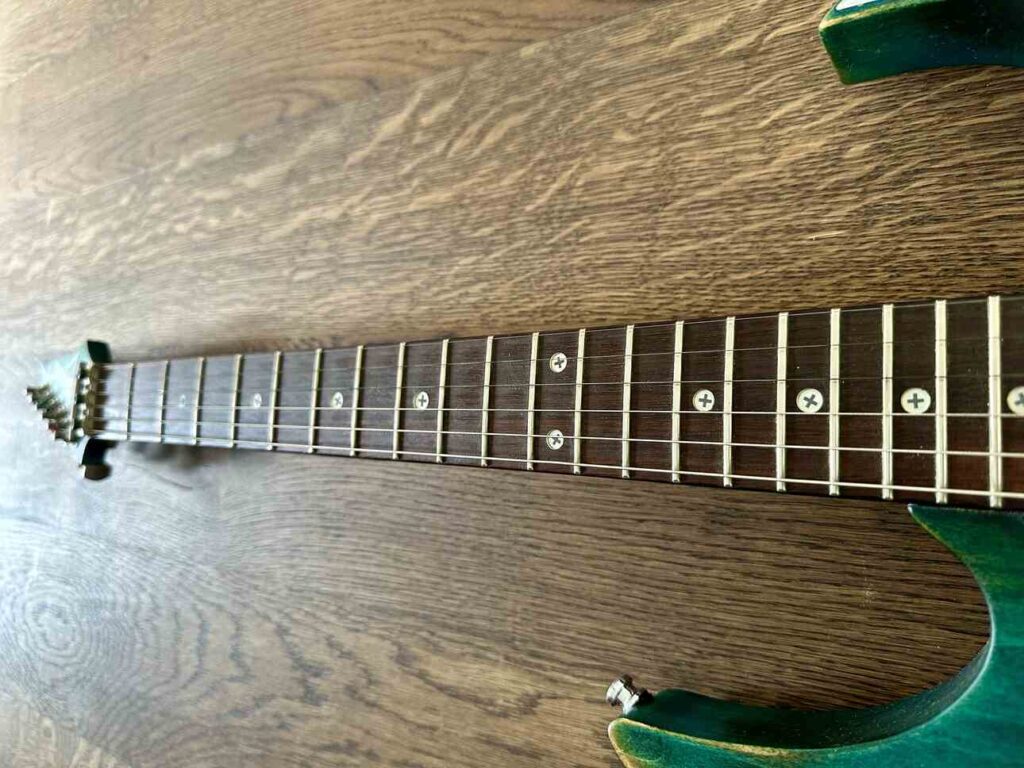
Importance of Neck Taper
The taper of a guitar neck can affect how comfortable it is to play and influence string spacing. It benefits several playing styles.
Comfort and Playability
A tapered neck helps your thumb and fingers move more easily along the fretboard. When the neck gradually narrows, it fits the natural curve of your hand well.
This is particularly noticeable during longer playing sessions. A well-tapered neck reduces hand fatigue.
Different scale lengths also feel easier to navigate with the right taper.
For instance, with a tapered neck, your fingers naturally find their place on the frets. It makes every chord and note feel more intuitive and less straining.
Neck taper also offers a better grip for players with different hand sizes.
A wide neck near the body narrows as it gets closer to the headstock, allowing all hand sizes to comfortably hold and maneuver the guitar.
Influence on String Spacing
The taper of a guitar neck has a significant impact on string spacing.
String spacing influences your ability to hit individual strings without accidentally striking others.
Tapering toward the nut brings the strings closer together.
Thanks to the neck’s changing width, you can easily shift from strumming to soloing.
If you prefer a specific playing style, the neck taper can help enhance that experience by precisely adjusting string spacing.
Varieties of Neck Shapes
Different guitar neck shapes can change how a guitar feels and plays. Knowing these shapes helps you pick a guitar that suits your hand size and playing style.
Common Neck Profiles
Guitar necks come in a few basic shapes, the most popular being C-shape, V-shape, and U-shape.
These names describe the cross-section of the neck.
- C-shape: Rounded and comfortable;
- V-shape: Tapered with a more pointed back;
- U-shape: Flat and broad.
Guitar necks come in a few basic shapes, the most popular being C-shape, V-shape, and U-shape
While some people would go as far as to pinpoint a certain shape to a certain style of music, I don’t like doing this.
In my experience the shape of your neck is matter of preference. Try the different shapes, and discover what feels best to your hands and your playing.
The C-Shape vs. V-Shape
The C-shape is the most common. It’s smooth and curves evenly, fitting snugly in your palm. Many players find it comfortable for chord playing and soloing.
Meanwhile, the V-shape has a pointed ridge down the back. This creates a more stable base for your thumb.
It can be further divided into soft V and hard V. Soft Vs. are rounded a bit, while hard Vs. have a sharper edge.
This shape is ideal if you like to grip the neck more tightly.
Asymmetrical and Thin Necks
Asymmetrical necks are designed with one side thicker than the other. This fits the natural contours of your hand better.
Players who shift between chords and fast leads will appreciate this design.
Thin necks, known as slim profiles, are popular with shredders and fast players. These necks allow faster movement up and down the fretboard, reducing hand fatigue.
They’re often found on modern electric guitars aimed at technical genres like metal or punk rock.
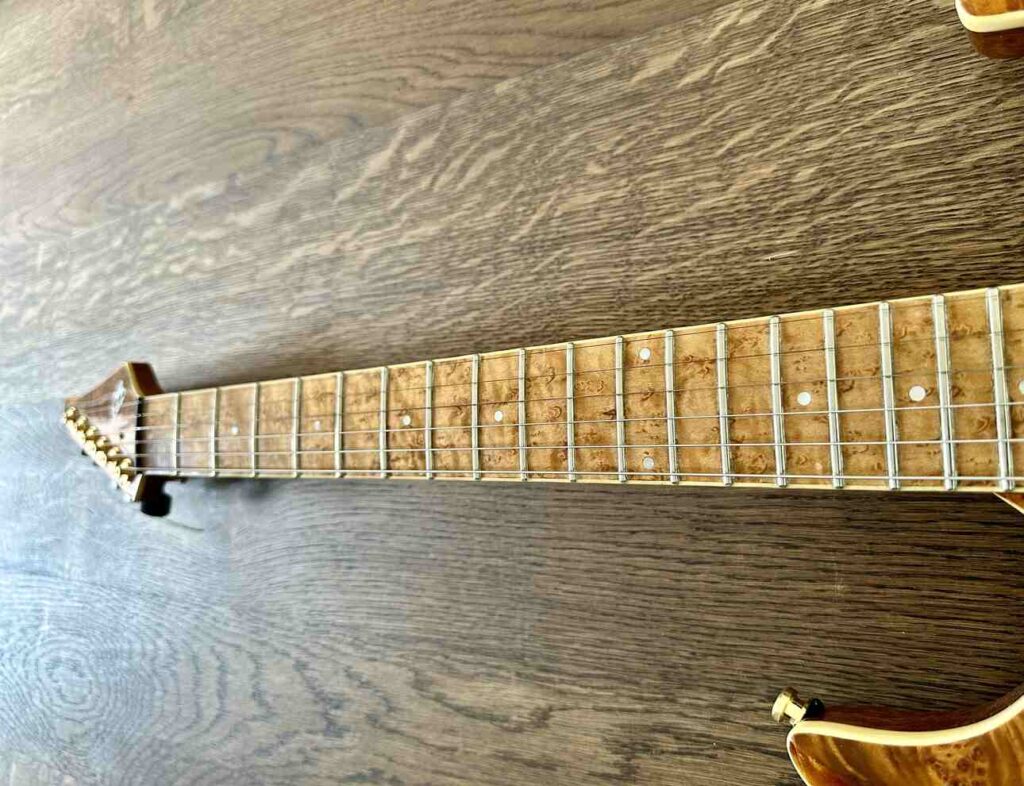
Factors Affecting Neck Shape and Taper
A guitar’s neck shape and taper are influenced by various factors. This includes the type and model of the guitar, player preferences, and historical and brand influences.
Each of these aspects plays a crucial role in determining the feel and playability of your axe.
Guitar Type and Model
Different guitars, like acoustic, electric, and classical, have varying neck shapes and tapers.
For instance, electric guitars like Fenders often have thinner necks. It allows easier access to higher frets.
In contrast, acoustic guitars usually have thicker necks to support the string tension.
Model-specific variations are common. For example, certain Gibson models might feature a rounded taper. In contrast, others might have a slim taper neck. This affects how you position your hand and move between chords.
Player Preference and Technique
Your playing style and personal comfort are crucial in the neck’s shape and taper.
Players who prefer fast, technical playing might opt for a thinner, more tapered neck. This neck design allows quicker hand movement and ease in playing complex pieces.
Techniques like fingerpicking or barre chords can influence your choice.
Fingerstyle players often favor a wider neck for better string spacing. In contrast, shredders may favor a slender neck for swift, nimble playing.
Your hand size and finger length also affect what feels most comfortable and natural.
Historical and Brand Influences
Over time, guitar neck designs have evolved due to trends and brand-specific styles.
Like those designed by Torres, vintage guitars often had a wider, less tapered neck than modern instruments.
Brands like Fender and Gibson have distinct design philosophies influencing their neck shapes.
A Fender, for instance, often has a more tapering neck. This is influenced by the need for playability and performance. At the same time, Gibson might stick to a thicker profile in some models for added stability and tone.
How to Choose the Right Neck for You
Finding the right guitar neck can improve your playing experience. This involves understanding your playing style, trying various necks, and considering custom modifications.

Analyzing Your Playing Style
Your playing style affects which neck will suit you best.
If you play fast, you might prefer a thin, flat neck. This type allows quicker movements and easier access to higher frets. Many solo guitarists love these necks.
A thicker neck may be ideal for playing rhythm guitar and using many barre chords. It offers more support and comfort, reducing hand fatigue.
Consider your hand size, too.
Players with smaller hands might find a thinner neck more comfortable. If you have larger hands, you might prefer a thicker one.
Trying Out Different Necks
Visit a music store and try out different guitars. This hands-on approach lets you feel the differences between neck shapes and sizes.
Consider common neck shapes like C-shaped, V-shaped, and U-shaped.
C-shaped necks are popular and versatile. It makes them a solid choice for many guitarists.
V-shaped necks offer a vintage feel and can be comfortable for thumb-over players. U-shaped necks are thicker and might be suitable for players needing extra support.
Play chords, scales, and favorite riffs to see which neck feels best.
Custom Necks and Modifications
Custom necks might be the answer if standard options don’t please you. Custom shops can build necks to your specifications, from shape to material.
This way, your guitar is tailored to fit your needs.
Some players love neck profiles that combine elements from different shapes. For example, a custom hybrid shape can provide both speed and comfort.
You can also get modifications. Like scalloping the fretboard for better note control. Or adding specific inlays for aesthetic appeal.
By opting for a custom neck, you ensure it exactly matches your play style and preferences.
Finding the best guitar neck involves balancing personal preference and practical needs. You can find the perfect fit by examining your style, trying out different guitars, and exploring custom options.
Frequently Asked Questions
What purpose does the taper of a guitar neck serve?
The taper of a guitar neck makes it easier to reach higher frets. It also helps with hand positioning, ensuring better technique and comfort during play.
Is there a difference in taper between electric and acoustic guitar necks?
Yes, electric guitar necks often have slimmer tapers compared to acoustic guitars. This makes it easier to play fast solos, while acoustic guitars usually have wider necks for fingerstyle playing.
What is the ideal taper for a comfortable guitar neck?
The ideal taper depends on personal preference. Some players prefer a narrow taper for quick movements, while others like a wider neck for support and comfort.
How does the taper of the neck affect guitar playability?
A well-designed taper makes it easier to play chords and scale runs. It helps reduce strain on your hand, allowing longer playing sessions without discomfort.
In what way does neck taper contribute to guitar design?
Neck taper is crucial for balancing the guitar’s design. It impacts weight distribution and the aesthetic look, contributing to the instrument’s feel and playability.
Can the taper of a guitar neck affect sound quality?
Yes, indirectly the taper can influence sound quality. Because a neck that fits well in your hand can lead to better playing techniques. This directly impacts the sound you produce.

